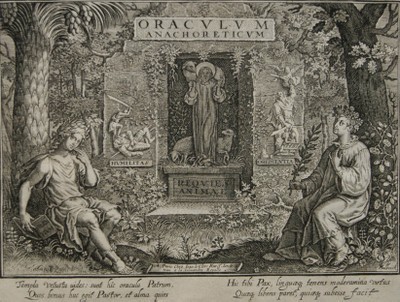Gallery 8: The Blessed Anchorites of Cuzco
Abstract
An anchorite or eremite is an individual who chooses to withdraw from society in order to lead a life focused on prayer, penance, and religious study. In the West, anchoritic life was common during the Early and High Middle Ages, and was the forerunner of Christian monastic life (although only in 1983 did Pope John Paul II lay down the norms for anchoritic or eremitic life to count as a form of consecrated Catholic life on a par with the lives led by monks and nuns of religious orders).
Images of anchorites abound in Christian art, including the variant that took root in the farflung territories of the Spanish Empire. A little known depiction of anchorites (and anchoresses, their female counterparts) is provided by the eighteen paintings that were once displayed at the Claustro del Noviciado, Convento de la Recoleta, Cuzco, Peru. Unfortunately, seismic damage to the walls of this cloister forced the removal of these paintings from public view at the novitiate and their relocation to undisclosed grounds, where they remain safe and secure.
As far as we can tell, the paintings of the anchorites of Cuzco was photographed professionally for the first time in 2009 by a PESSCA team headed by Daniel Giannoni and supported by the Catholic University of Peru (PUCP). The pictures resulting from this joint effort appear in this website for the first time (together with our heartfelt thanks to both Daniel and to the PUCP).
Notice of the existence of these paintings was served in Estabridis (1989), where the paintings in question were placed in indirect correspondence with the Oraculum Anachoreticum—a series of engravings of anchorites made by Johan Sadeler I and Raphael Sadeler I at the end of the 16th century and published in Venice in 1600 (a digital version of this work can be found in the Portuguese National Library, as Gustavo Vives pointed out to me). Beyond this, Estabridis argued that the Cuzco anchorites could be placed in direct correspondence with an engraved copy of the Oraculum Anachoreticum made in Paris early in the 17th century. One of these copies was discovered by Estabridis himself in the Peruvian National Library; another one can be found in the Biblioteka Zgromadzenia Księży Misjonarzy w Krakowie. The title page of this publication has been reproduced above.
The pioneering work of Estabridis led us beyond the Oraculum Anachoreticum to other series of anchorites engraved by the Sadelers. They are the Solitudo Sive Vitae Patrem Eremicolarum, and the Trophaeum Vitae Solitariae. Both of these series served as additional sources, direct or indirect, of the anchorites of Cuzco. But our research also led us beyond the Sadelers to the Collaerts, whose Solitudo Sive Vitae Foeminarum Anachoritarum could well provide the direct sources of the paintings of the anachoresses of the Cuzco series. The designs for all of these series come from Maarten de Vos—probably from information found in the Legenda Aurea of Jacobus de Voragine and in the Vitae Sanctorum of Laurentius Surius (cf. The Illustrated Bartsch, Volume 70, Part 2 (Supplement), Page 169).
Following the navigation panel below will lead the visitor to all of these discoveries. We have been able to place fifteen of the eighteen paintings of the blessed anchorites of Cuzco in correspondence with their engraved sources. But the sources of the remaining three paintings still elude us. They are the depictions of John the Baptist, Mary Magdalen, and Mary the Egyptian. We present these unsourced paintings below in the hopes that some future visitor to this gallery will be able to pinpoint the engravings that served as their models—and will be willing to share their discovery with the rest of us.


